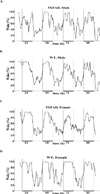Increased fragmentation of sleep-wake cycles in the 5XFAD mouse model of Alzheimer's disease
- PMID: 25637807
- PMCID: PMC4361816
- DOI: 10.1016/j.neuroscience.2015.01.035
Increased fragmentation of sleep-wake cycles in the 5XFAD mouse model of Alzheimer's disease
Abstract
Sleep perturbations including fragmented sleep with frequent night-time awakenings and daytime naps are common in patients with Alzheimer's disease (AD), and these daily disruptions are a major factor for institutionalization. The objective of this study was to investigate if sleep-wake patterns are altered in 5XFAD mice, a well-characterized double transgenic mouse model of AD which exhibits an early onset of robust AD pathology and memory deficits. These mice have five distinct human mutations in two genes, the amyloid precursor protein (APP) and Presenilin1 (PS1) engineered into two transgenes driven by a neuron-specific promoter (Thy1), and thus develop severe amyloid deposition by 4 months of age. Age-matched (4-6.5 months old) male and female 5XFAD mice were monitored and compared to wild-type littermate controls for multiple sleep traits using a non-invasive, high throughput, automated piezoelectric system which detects breathing and gross body movements to characterize sleep and wake. Sleep-wake patterns were recorded continuously under baseline conditions (undisturbed) for 3 days and after sleep deprivation of 4h, which in mice produces a significant sleep debt and challenge to sleep homeostasis. Under baseline conditions, 5XFAD mice exhibited shorter bout lengths (14% lower values for males and 26% for females) as compared to controls (p<0.001). In females, the 5XFAD mice also showed 12% less total sleep than WT (p<0.01). Bout length reductions were greater during the night (the active phase for mice) than during the day, which does not model the human condition of disrupted sleep at night (the inactive period). However, the overall decrease in bout length suggests increased fragmentation and disruption in sleep consolidation that may be relevant to human sleep. The 5XFAD mice may serve as a useful model for testing therapeutic strategies to improve sleep consolidation in AD patients.
Keywords: amyloid beta; diurnal rhythm; sleep; sleep fragmentation; sleep homeostasis.
Copyright © 2015 IBRO. Published by Elsevier Ltd. All rights reserved.
Figures



Similar articles
-
Effects of aging and genotype on circadian rhythms, sleep, and clock gene expression in APPxPS1 knock-in mice, a model for Alzheimer's disease.Exp Neurol. 2012 Aug;236(2):249-58. doi: 10.1016/j.expneurol.2012.05.011. Epub 2012 May 22. Exp Neurol. 2012. PMID: 22634208
-
Effects of BACE1 haploinsufficiency on APP processing and Aβ concentrations in male and female 5XFAD Alzheimer mice at different disease stages.Neuroscience. 2015 Oct 29;307:128-37. doi: 10.1016/j.neuroscience.2015.08.037. Epub 2015 Aug 24. Neuroscience. 2015. PMID: 26314636 Free PMC article.
-
Behavioral and EEG changes in male 5xFAD mice.Physiol Behav. 2014 Aug;135:25-33. doi: 10.1016/j.physbeh.2014.05.041. Epub 2014 Jun 4. Physiol Behav. 2014. PMID: 24907698
-
The sleep-wake cycle and Alzheimer's disease: what do we know?Neurodegener Dis Manag. 2014;4(5):351-62. doi: 10.2217/nmt.14.33. Neurodegener Dis Manag. 2014. PMID: 25405649 Free PMC article. Review.
-
Bidirectional relationships between sleep and amyloid-beta in the hippocampus.Neurobiol Learn Mem. 2019 Apr;160:108-117. doi: 10.1016/j.nlm.2018.06.009. Epub 2018 Jun 15. Neurobiol Learn Mem. 2019. PMID: 29908972 Review.
Cited by
-
The Potential Roles of Ghrelin in Metabolic Syndrome and Secondary Symptoms of Alzheimer's Disease.Front Neurosci. 2020 Sep 24;14:583097. doi: 10.3389/fnins.2020.583097. eCollection 2020. Front Neurosci. 2020. PMID: 33071750 Free PMC article. Review.
-
Bidirectional relationship between sleep and Alzheimer's disease: role of amyloid, tau, and other factors.Neuropsychopharmacology. 2020 Jan;45(1):104-120. doi: 10.1038/s41386-019-0478-5. Epub 2019 Aug 13. Neuropsychopharmacology. 2020. PMID: 31408876 Free PMC article. Review.
-
Rodent Models of Alzheimer's Disease: Past Misconceptions and Future Prospects.Int J Mol Sci. 2024 Jun 5;25(11):6222. doi: 10.3390/ijms25116222. Int J Mol Sci. 2024. PMID: 38892408 Free PMC article. Review.
-
Sleep in Alzheimer's Disease - Beyond Amyloid.Neurobiol Sleep Circadian Rhythms. 2017 Jan;2:4-14. doi: 10.1016/j.nbscr.2016.08.002. Epub 2016 Aug 10. Neurobiol Sleep Circadian Rhythms. 2017. PMID: 28217760 Free PMC article.
-
Evaluation of hippocampal DLGAP2 overexpression on cognition, synaptic function, and dendritic spine structure in a translationally relevant AD mouse model.bioRxiv [Preprint]. 2025 May 14:2025.05.13.653830. doi: 10.1101/2025.05.13.653830. bioRxiv. 2025. PMID: 40462999 Free PMC article. Preprint.
References
-
- Bliwise DL. Sleep disorders in Alzheimer's disease and other dementias. Clin Cornerstone. 2004;6(Suppl 1A):S16–S28. - PubMed
Publication types
MeSH terms
Substances
Grants and funding
LinkOut - more resources
Full Text Sources
Other Literature Sources
Medical
Molecular Biology Databases
Miscellaneous

